Special Feature: Products Sally Recommends
Bordeaux Avec mes Amis —neuf
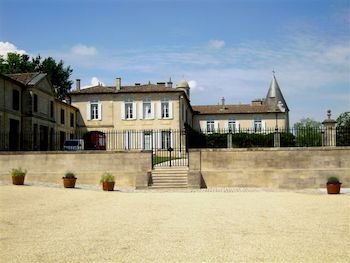 Not a significant drive from our last appointment in Beychevelle, we headed north to Pauillac, taking the prescribed route through town and then westward to Chateau Lafite Rothschild. Again, we were very early, so their gravel parking lot was the place where we opted to eat lunch. Following our repast, the glorious grounds of the Chateau beckoned. There were the Rothschild private gardens, where fresh produce was farmed, the private lake and the grand hill (“lafite”) with vines carefully contoured for drainage and maximum sunshine exposure to the forthcoming summer clusters. The guys wondered off, knowing well the time for our visit was still in the distance. I remained close by, aware that sometimes there are opportunities for commencement earlier than scheduled. Surely enough, our host Nicola appeared and asked if I was with the party scheduled for 2 pm. With my confirmation, I asked for his patience while I rounded up the troops. We were able to commence shortly thereafter.
Not a significant drive from our last appointment in Beychevelle, we headed north to Pauillac, taking the prescribed route through town and then westward to Chateau Lafite Rothschild. Again, we were very early, so their gravel parking lot was the place where we opted to eat lunch. Following our repast, the glorious grounds of the Chateau beckoned. There were the Rothschild private gardens, where fresh produce was farmed, the private lake and the grand hill (“lafite”) with vines carefully contoured for drainage and maximum sunshine exposure to the forthcoming summer clusters. The guys wondered off, knowing well the time for our visit was still in the distance. I remained close by, aware that sometimes there are opportunities for commencement earlier than scheduled. Surely enough, our host Nicola appeared and asked if I was with the party scheduled for 2 pm. With my confirmation, I asked for his patience while I rounded up the troops. We were able to commence shortly thereafter.
The guys were really impressed as we entered the relatively small above ground service buildings and descended into the massive labyrinth which was the winery and storage chambers below. Nicola took us through the rooms where grapes were sorted and the wine created. They utilize traditional wooden vats for fermenting the Cabernet Sauvignon and modern concrete vats for the Merlot. The property has 110 hectares under vine, with 70% Cabernet, 25% Merlot, 3% Cabernet Franc and 2% Petit Verdot. Each year the final blends are aged 18 months in new oak barrels, yielding over 16 thousand cases of the Grand Vin.
The rotunda for barrel storage and racking was completely full, with sediment removal underway in the most recent vintage. Even for my second visit, the view was breathtaking, with normal day-to-day winemaking processes taking place in a room which doubles for a symphonic concert hall. Just on the perimeter of this subsurface spectacle was the station where our wine tasting was prepared. We were offered full pours of the 2001 vintage. It was really nice, but not the bold expression that the 1995 sample had been, two years back. No one felt slighted.
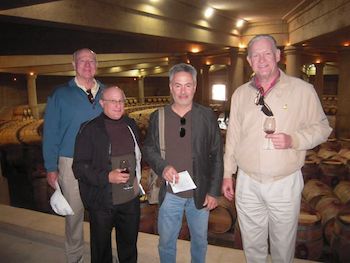 While we sipped, I asked Nicola if what I had heard about Lafite halting futures sales, along with nearby First Growth Latour, was true. He responded that they had in fact sold 2012 futures to the Negociants for around 400E per bottle. Thus the report I had heard was not entirely valid, or possibly the owners had changed their minds after calculating the adverse economic impact of such a bold move. Departing we passed the dank, musty cellar where the Rothschild’s personal bottles are stashed. The oldest in captivity remains 1797. We thanked him for the tour and slowly departed, cherishing the experience.
While we sipped, I asked Nicola if what I had heard about Lafite halting futures sales, along with nearby First Growth Latour, was true. He responded that they had in fact sold 2012 futures to the Negociants for around 400E per bottle. Thus the report I had heard was not entirely valid, or possibly the owners had changed their minds after calculating the adverse economic impact of such a bold move. Departing we passed the dank, musty cellar where the Rothschild’s personal bottles are stashed. The oldest in captivity remains 1797. We thanked him for the tour and slowly departed, cherishing the experience.
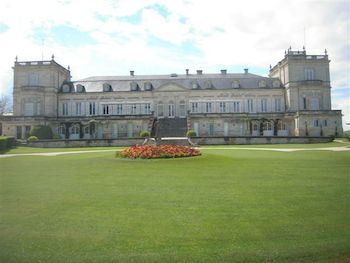 Chateau Ducru Beaucaillou was our next stop, and I wanted to arrive there as soon as possible, hopeful that the visit would not adversely impact what was scheduled later that evening. We were early and I walked into the business office of this most impressive Chateau, which faces La Gironde. It turned out to be the home of Owner, Bruno Borie, the business office and on the lower level, the laboratory, tasting room and library storage chambers. After announcing our arrival, I was assured that the Cellar Master was on his way. In ten minutes, Rene Lusseau appeared and announced that he was to be our guide, speaking nary a word of English. This was initially confusing to me, because the representative of Berry Bros. & Rudd (British Wine Merchants), who arranged this very rare tour, knew we only spoke in the tongue of “Sovereign Lizzie.” Rene was a very delightful soul, determined to make the best of what he too recognized as an awkward situation.
Chateau Ducru Beaucaillou was our next stop, and I wanted to arrive there as soon as possible, hopeful that the visit would not adversely impact what was scheduled later that evening. We were early and I walked into the business office of this most impressive Chateau, which faces La Gironde. It turned out to be the home of Owner, Bruno Borie, the business office and on the lower level, the laboratory, tasting room and library storage chambers. After announcing our arrival, I was assured that the Cellar Master was on his way. In ten minutes, Rene Lusseau appeared and announced that he was to be our guide, speaking nary a word of English. This was initially confusing to me, because the representative of Berry Bros. & Rudd (British Wine Merchants), who arranged this very rare tour, knew we only spoke in the tongue of “Sovereign Lizzie.” Rene was a very delightful soul, determined to make the best of what he too recognized as an awkward situation.
He took us to the impressive wine making and storage chamber, constructed on the downward slope of the hillside, adjacent to where the Chateau was positioned. There were concrete walls, resembling concrete tiltwall panels which outlined the facility and a concrete roof. The soils from excavations into the hillside were ramped upon the walls and spread over the roof structure, offering bedded surfaces for the grass and ivy cover to provide natural insulation for the facility, greatly reducing the cost of air-conditioning. Rene’s attempts to communicate were as much with his hands as any other resource. Although not very informative, his expressions were entertaining, and we were pleased to have the opportunity to at least see these well sequestered components of this winery, which yields a product we all love. Our tour of the grounds needed no dialog. They were immaculately kept, similar to sculpted floral gardens in Paris during springtime.
In the basement chamber of the Chateau, Rene showed us the 2011 re-designed bottle of their second wine (Croix de Beaucaillou) by jewelry designer Jade Jagger (yes, Mick’s daughter). Then with a fanfare of unrecognizable, but amusing waves and chants he escorted us into the tasting room, where we were offered barrel samples of all their 2012 wines. Most notable, of course, was the Grand Vin. The nose was of flowers, cedar and graphite, with a medium bodied pepper spiced, dark fruit palate. Unfortunately, it was not the powerhouse of several of the mid-90’s vintages I have enjoyed, and likely will not compare to the great vintages of 09 and 10. The tour ended early enough, so as not to conflict with the finale, which was confirmed only two days before, Chateau Margaux.
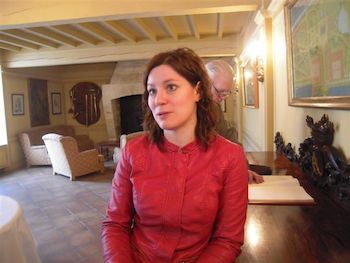 What can I say about Marie Guillard, in charge of Reception and Visits for Chateau Margaux? Some of the most interesting people you meet in life are like complex puzzles, resisting categorization. Marie dwells in that realm. My first email encounters with her were in 2011, when I initially sought (in vain) to visit the winery. Returned responses were polite, but firm in her insistence that the property was closed to all visitors for renovation. I did discover she was a friend of my buddy Sonia at Chateau Latour, and thus I prevailed upon her for help reaching out to Marie for the 2013 trip. Marie’s first response was again polite, yet insisting that the facility remained under renovation. Her associate Emilie answered one of my pesky follow-up emails (during Marie’s vacation) indicating that it was possible for a visit in May, but asked me to contact Marie in March. When I did, her response again seemed doubtful. This, I took for another rejection. Yet, after a few days, Marie surprised me with a note that May 3 might be possible. She tossed out a time for my consideration. That late in the scheduling process, all the normal time-slot commitments had been secured for the entire week. I replied that we were unable to change our agenda, and that our final Left Bank visits on May 2 had us fully booked, with a 4 pm. appointment at Ducru Beaucaillou, unless… she was willing to see us afterward, as late as 6 pm. Twas a “long-shot” at best. My two trips worth of booking experience in Bordeaux convinced me that the answer would be “mais non.” She responded that a 6 pm. visit would be highly unusual, and she would need to ask permission from those who handled the alarm systems. To me this again seemed like another pending rejection. Days later, Marie did not mention the alarm permission in her reply, only the fact that she had to take her husband to the doctor that afternoon. My response to her, just before our departure to France was a polite but sad acceptance of defeat. To my delightful surprise, upon checking my email on Tuesday evening in Libourne (described in Chapter Six), she apologized for not being clear, but emphasized that she would meet us late. I do not believe that any person working at any other Bordeaux winery would have bothered to accommodate in this after-hours fashion, compromising personal family-time. Marie instantly became my candidate for sainthood.
What can I say about Marie Guillard, in charge of Reception and Visits for Chateau Margaux? Some of the most interesting people you meet in life are like complex puzzles, resisting categorization. Marie dwells in that realm. My first email encounters with her were in 2011, when I initially sought (in vain) to visit the winery. Returned responses were polite, but firm in her insistence that the property was closed to all visitors for renovation. I did discover she was a friend of my buddy Sonia at Chateau Latour, and thus I prevailed upon her for help reaching out to Marie for the 2013 trip. Marie’s first response was again polite, yet insisting that the facility remained under renovation. Her associate Emilie answered one of my pesky follow-up emails (during Marie’s vacation) indicating that it was possible for a visit in May, but asked me to contact Marie in March. When I did, her response again seemed doubtful. This, I took for another rejection. Yet, after a few days, Marie surprised me with a note that May 3 might be possible. She tossed out a time for my consideration. That late in the scheduling process, all the normal time-slot commitments had been secured for the entire week. I replied that we were unable to change our agenda, and that our final Left Bank visits on May 2 had us fully booked, with a 4 pm. appointment at Ducru Beaucaillou, unless… she was willing to see us afterward, as late as 6 pm. Twas a “long-shot” at best. My two trips worth of booking experience in Bordeaux convinced me that the answer would be “mais non.” She responded that a 6 pm. visit would be highly unusual, and she would need to ask permission from those who handled the alarm systems. To me this again seemed like another pending rejection. Days later, Marie did not mention the alarm permission in her reply, only the fact that she had to take her husband to the doctor that afternoon. My response to her, just before our departure to France was a polite but sad acceptance of defeat. To my delightful surprise, upon checking my email on Tuesday evening in Libourne (described in Chapter Six), she apologized for not being clear, but emphasized that she would meet us late. I do not believe that any person working at any other Bordeaux winery would have bothered to accommodate in this after-hours fashion, compromising personal family-time. Marie instantly became my candidate for sainthood.
We exchanged telephone numbers and I promised to call her as soon as we departed from Ducru. We both knew about how long a drive that would be. I promised to hurry. The early start and language complications in the Ducru visit served to hasten its conclusion, placing us on the road in time to be at Margaux just after 5 pm. She was happy to receive the call, letting me know she was completing a project and would be available soon. Entering the Accueil doorway, we were instructed to wait in a formal sitting room for her arrival. After 10 minutes, Marie entered the room and introduced herself to everyone. As she extended her hand, I “took a knee” and thanked her.
We followed her across the grounds and into a locked, gated courtyard which accessed their museum entrance to the winery, with an impressive scaled model of the grounds and buildings in the complex. There she offered a brief history of the property and its ownership. Chateau Margaux came into prominence in the 1570’s, under Pierre de Lestonnac. By 1770, the estate had 262 hectares, a third of which was planted. Thomas Jefferson declared it as one of the “four vineyards of first quality,” while visiting France in 1787. During the French Revolution, its owner, Ellie du Barry, was executed (“thwaaack”) and the property awarded to a “citizen.” As it fell into disrepair, the estate was sold. The old medieval castle was torn town by the new owner, Bertrand Douat, and the current day Chateau was completed as a residence by 1812. Margaux was acquired by the Ginestet family (then owners of Lascombes), and remained with heirs until purchased in 1976 by French financial group, Felix Potin, led by Andre Mentzelopoulos. His daughter Corinne became sole share holder in 2003.
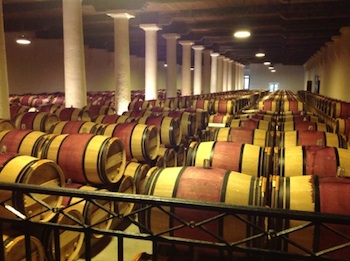 Marie explained that the recent renovations were to accommodate additional storage, allowing the Chateau to hold 20% of wines produced each year, for later sale. Also created were new truck loading facilities and new experimental cellars for research. Picking of grapes is by hand, with sorting done in the field. The red wines of Margaux are fermented in mostly wooden tanks, aged 18 to 24 months in 100% new oak (in-house coopers) and then blended after aging, during which decisions are made as to which wines will become the Grand Vin or the second label, Pavillion Rouge. Eighty percent humidity is maintained in the storage vaults by water-spray misting. Twelve hectares of Sauvignon Blanc are grown and transformed into their smaller production of Pavillon Blanc.
Marie explained that the recent renovations were to accommodate additional storage, allowing the Chateau to hold 20% of wines produced each year, for later sale. Also created were new truck loading facilities and new experimental cellars for research. Picking of grapes is by hand, with sorting done in the field. The red wines of Margaux are fermented in mostly wooden tanks, aged 18 to 24 months in 100% new oak (in-house coopers) and then blended after aging, during which decisions are made as to which wines will become the Grand Vin or the second label, Pavillion Rouge. Eighty percent humidity is maintained in the storage vaults by water-spray misting. Twelve hectares of Sauvignon Blanc are grown and transformed into their smaller production of Pavillon Blanc.
Following our tour of the wine making and storage areas, we returned to the chamber where we had entered. There Marie offered us samples of the 2008 Chateau Margaux and Pavillon Rouge. The second wine (68% Cabernet and 26% Merlot) was impressive, with a nose of wild berries and spice, and a palate of soft and sweet tannins. The Grand Vin (87% Cabernet and 10% Merlot) had a more floral nose, with supple richness and a longer finish. In comparison, I concluded that a highly rated Pavillon Rouge (such as the 2010) would offer much of the fragrant, flavorful enjoyment of a first tier Margaux, at a more affordable price.
Marie walked us out to the gate, unlocking it for our exit. Again we thanked her for her kindness, and then she returned to the tasting area to close down the building, no doubt initiating the alarm codes with which she was entrusted for this special after-hour presentation. As we approached our car, a light rain began to fall. Our departure was slow as we caught our final glimpse of this incredible property, the likes of which we may never see again, along with the beautiful visage of the newest patron saint of the Margaux estate, Marie Guillard.
The skies promptly cleared, and we enjoyed a spectacular red-sky evening drive back to our Libourne home. Chef Christophe had been informed of our later expected arrival, so he was in the kitchen preparing one of the five course meals he had planned for the week. As usual the fare was exquisite. Calvin and I had brought along a couple of Napa classic bottles that we decided to open that evening. The day could not have possibly been much better. “Vendredi” would regretfully be our final day to tour Bordeaux. The Right Bank would be our destination.
Chateau Lafite Rothschild
www.lafite.com
Chateau Ducru Beaucaillou
www.chateau-ducru-beaucaillou.com
Chateau Margaux
www.chateau-margaux.com
Note: This information was accurate when it was published. Please be sure to confirm all rates and details directly with the businesses in question before making your plans.



